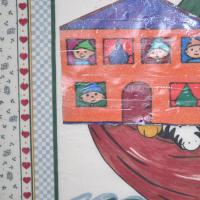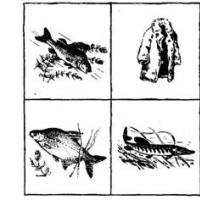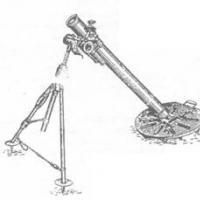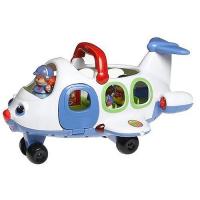Differentiation of speech material. Cards for homework "differentiation of sounds y - l". Pronunciation of sounds in words. Sound analysis and synthesis
Goal: Consolidating the skill of distinguishing the sounds L-L in syllables, words, phrases.
Objectives: Continue to teach how to differentiate sounds by hardness and softness, sound analysis. Drawing up proposals for supporting subjects. Develop phonemic awareness, coherent speech, imagination, thinking, general and fine motor skills, attention, memory. The use of expressive movements in the education of emotions, the acquisition of skills in self-relaxation.
Equipment: magnetic board, magnets, colored pencils, pictures of the sounds L-L, individual cards with flashlights (green and blue) and images of objects with the sounds L-L in their names
Progress of the lesson
1. Organizational moment
Exercises to activate attention:
Game “Reach your hand”.
- Come on, right hand, reach for your left ear. And you, left hand, to the right eye: And so on.
– Hello, children, today we have an unusual activity: guests have come to us, they are smiling at you. And you will smile at your guests. Smile at each other. Smile for me too.
2. Subject message
– But you will find out what we will do in class when you listen to the poem. And don’t just listen, but try to determine which sound is heard most often in this poem?
Mom was giving the baby a bath.
I washed my naked body with soap and washcloth.
Mila stood next to her mother,
She poured warm water over the baby.
Allochka will gently dry the baby
A warm, shaggy, large towel.
– [L]
- Right. Today we will learn to correctly distinguish between the sounds L and L.
3. Articulation gymnastics, breathing exercises
– And in order to speak the sounds L and L correctly and beautifully, we must train our breathing, lips and tongue.
Development of lower diaphragmatic breathing:
Inhale (through the nose) - exhale pfft
Inhale (through the nose) - exhale pfft, pfft
Inhale (through the nose) - exhale pfft, pfft, pfft
With sounds:
Inhale (through the nose) - exhale A
Inhale (through the nose) – exhale JSC
Inhale (through the nose) – exhale AOU
Tongue exercises:
“WATCH.” The mouth is slightly open. The lips are stretched into a smile. Using the tip of your narrow tongue, alternately reach towards the corners of your mouth.
“SNAKE”. The mouth is wide open. Push the narrow tongue forward and move it deep into the mouth.
"SWING". The mouth is open. With a tense tongue, reach for the nose and chin or the upper and lower incisors.
“HIDE THE CANDY.” Mouth closed. With a tense tongue, rest on one or the other cheek.
"BRUSH YOUR TEETH". Mouth closed. Move your tongue in a circular motion between your lips and teeth.
"COIL". The mouth is open. The tip of the tongue rests on the lower incisors, the lateral edges are pressed against the upper molars. The wide tongue “rolls out” forward and retracts into the depths of the mouth.
“TASTY JAM.” The mouth is open. Using a wide tongue, lick your upper lip and move your tongue into the back of your mouth.
Guys, let's repeat the sayings ( pure sayings familiar to children)
La-la-la, la-la-la - didn’t notice the glass
Lu-lu-lu, lu-lu-lu - we didn’t hit the glass
La-la-la, la-la-la - but there is no glass in the windowLu-lu-lu, lu-lu-lu - near the windows on the floor
Ly-ly-ly, ly-ly-ly - we scored goalsLi-li-li, li-li-li - poplars are visible in the distance
Le-le-le, le-le-le - we have a lot of them in our village
La-la-la, la-la-la - but they make the earth go down
La-la-la, la-la-la - we all love poplars
Lu-lu-lu, lu-lu-lu - poplars and I loveLa-la, la-la, la-la-la - Lena had a doll
Li-ly, li-ly, li-ly-ly – felt boots are too small for a doll
Le-lo, le-lo, le-lo-lo - the doll’s coat is warmLo-lo-lo, lo-lo-lo – it’s warm outside
Lu-lu-lu, lu-lu-lu - the table is in the corner
Ul-ul-ul - our chair is broken
Ol-ol-ol - we bought salt.
4. Development of phonemic awareness
Isolating the sound L from a number of isolated sounds.
– I will make sounds, and you clap your hands when you hear the sound L (V L T L N S L L F L).
Isolating a syllable with the sound L from a number of syllables.
– I will pronounce the syllables, and you will clap your hands when you hear a syllable with the sound L (MA LA RO LO KU LU SY LY TU).
Isolating a word with the sound L from a number of words.
- Children, you and I know the hard sound L and the soft sound L. Now I will tell you words in which you can hear l and l. If the word contains a soft sound L, you will pick up a green card, and if there is a hard sound L, you will pick up a blue card.
Example words: chalk, stranded, moth, stake, corner, coal, prick, boat, ice, hatch, bow, flax, skis, linden.
Using the same pattern, we can distinguish names with a soft syllable la: Alla, Alya, Milya, Mila, Kolya, Olya.
The exercise is also carried out with the setting of color signals for the sounds l and l.
5. “Light a flashlight.”
- Guys, more guests came to our lesson, my sister and brother, Lada and Lyosha (dolls are hung on a magnetic board). Annex 1
Look what kind of clothes they have - blue for Lada, green for Lyosha. Why do you think?
– Because the sound L in the word Lada is hard, it is indicated by blue. And the sound L in the word Lesha is soft, it is indicated by the color green.
– It is necessary to sort out the pictures for Lada and Lyosha, pronouncing the name of the picture and clearly highlighting the sounds L, L. The pictures are hung on a magnetic board.Appendix 2
6. Pronunciation of sounds in words. Sound analysis and synthesis
– Guys, where is the sound [L], [L] in the names of the pictures: at the beginning, in the middle or at the end? Draw arrows to the diagrams. Appendix 3
7. Differentiation of hard and soft sounds L, L in words
A). Each child has one of the pictures: onion, potato, apple, lemon, strawberry, raspberry, gladiolus, lily, woodpecker, heron, robe, coat.
– Pictures with the sound L should be given to Lyosha, and with the sound L – to Lada.
b). The speech therapist displays Lada’s pictures on a magnetic board and asks them to select a pair of Lyosha’s pictures for each of them and explain their choice.
For example: Pola - fields, ironing - looking, spinning top - Julia, flags - flasks, clone - maple, bow - hatch, was - true, whole - goal, ate - spruce, became - steel, gave - distance, ardor - dust, corner - coal.
8. Game “Shelves”
Help Lada and Lyosha tidy up the closet and shelves. It is necessary to remove unnecessary items. Appendix 4
9. Consolidating the pronunciation of the sounds L – L in a phrase
Pronounce all words in the sentence correctly, clearly emphasizing the sounds L, L. ( The children complete the task one by one, repeating after the teacher.
Olya sang.
Our Julia is like a top.
Kolya has a flag in his hand and a flask on his side.
You can lay a roof, you can inhabit a house.
I unclenched my fist and there was a firefly in my palm.
We walked through the fields and divided everything we found in half.
Here are two dogs walking on their hind legs in fashionable hats.
No doubt the lion is strong, but he is weaker than the elephant.
Planes are flying, pilots are sitting in them.
A harvester on wheels is driving, cutting ripe ears of corn.
Luda, there is a puddle under your feet.
A jackdaw sat on the roof of the club and cleaned its beak.
Larisa needs not just any paint, but blue paint.
Pour coal into this corner.
A jackdaw walks along the pebbles by the river.
The alarm clock woke me up.
10. Finish your story by choosing your words
– Guys, Lada and Lyosha have come up with couplets for you, which you must complete by correctly choosing words that are close in sound and meaning. But pay attention that the words must contain the sounds L, L.
Bunny didn't listen to dad -
They crushed Bunny... ( paw).The children were sitting in the park
And ice cream...( ate).And near this Christmas tree
The evil ones wandered... ( wolves).Christmas tree, Christmas tree,
Kolkaya... ( needle).The duck began to sing to the mouse:
- Ha-ha-ha, go to sleep,... ( baby)!Often go to the lake to get drunk
The redhead walks... ( fox).The toad began to croak importantly:
- Kva-kva-kva, no need... ( cry)!Zag, let's play football!
Score quickly... ( Goal)!Suddenly the sky became cloudy,
Lightning from a cloud... ( sparkled).I don't run to the doctor -
I myself... ( I'm flying).We didn't eat, we didn't drink,
Snowy woman... ( sculpted).
Exercise “Say the words”
– Help Lada and Lesha make up words by choosing the correct syllable with the L sound.
11. Making sentences based on pictures
(Use words that have the L sound) Appendix 7
12. Summary of the lesson
a) Well done guys, you worked hard today. Lada and Lyosha are pleased with your answers.
b) Homework: solve riddles, learn one of the tongue twisters.
Bibliography:
- Burdina S.V. Speech therapy notebook for sounds [l], [l’]. – Kirov: Spring – design, 2006.
- Gening M. G., German N. A. Teaching preschoolers correct speech. A manual for kindergarten teachers. 4th edition. – Cheboksary: Chuvash Book Publishing House, 1980.
- Gerasimova A.S. Encyclopedia of development and education of preschoolers for 1–6 years. – M.: OLMA Media Group, 2009.
- Gerbova V.V. Classes on speech development for children 4–6 years old (senior mixed-age group): Book. for a kindergarten teacher garden – M.: Education, 1987.
- Lebedeva I.L. Difficult sound, you are our friend! Sounds L, L: A practical guide for speech therapists, educators, parents. – M.: Ventana-Graf, 2008.
- Maksakov A. I. Does your child say correctly: A manual for a childcare provider. garden – M.: Education, 1982.
- Maksakov A. I. Does your child say correctly: A manual for a childcare provider. garden – 2nd edition, revised – M.: Education, 1982.
- Morozova I., Pushkareva M. Speech therapist lessons. Let's learn to speak correctly. – M.: Dragonfly, 2010.
- Sunny bunny. Newspaper for preschoolers with tips for parents. – No. 6, March, 2010.
Automation of sound [th], differentiation [th] – [l].
- Pronounce the sound [th] clearly and loudly several times, with your lips in a smile, your teeth close and visible, the tip of your tongue behind the lower incisors.
- Pronounce the sound [th] in combination with vowelsa, e, o, y (i, e, e, yu).
- Say the interjections “ay!” and “oh!” and explain to the child in what cases they are used. Simultaneously perform facial movements. Ay! – be surprised (raise your eyebrows, show surprise on your face).
Oh! – it hurts (furrow your eyebrows, depict suffering on your face).
The child, following the adult, repeats interjections and performs facial movements.
4. Game "Guess what's wrong with me." An adult pronounces one of the interjections “ay!” or “Oh!”, and the child gives his face the appropriate expression - surprise or suffering. Then the adult depicts these same states, and the child voices them, saying “ah!” or “oh!”
5. Perform the exercise “Fingers say hello” while reciting:
a) syllables ay, oh, hey, y;
b) sounds: й+а=я, й+о=е, й+е=е, й+у=у.
Perform the exercise first with your right hand, then with your left hand, then with both hands at the same time.
6. Game "Sing Like a Bird". Ask the child to say the following pairs and chains behind him:
a – I I – La I – I – La
o – yo – le le – le - e
u – yu yu – lyu yu – lyu – yu
e – e e – le le – e – le
7. Speak pure talk:
Ay - ah - ah - throw the ball
Oh - oh - oh - with that hand
Hey - hey - hey - hit harder
El - el - el - right on target.
I - I - I, I - I - I - this is my song.
Yu - yu - yu, yu - yu - yu - I sing a song loudly.
E - e - e, e - e - e - I’ll give it to you.
Yo - yo - yo, yo - yo - yo - on your birthday.
8. Learn poems:
Fall, fall, fall, snow,
Make everyone happy, make everyone happy.
The spruce tree looks like a hedgehog
Spruce in needles, hedgehog too.
We drove, we drove,
We drove up to the pit,
We drove around the pit
9. Repeat the tongue twister:
Lena barely ate.
I didn’t want to eat out of laziness.
10. Game “Name it kindly.”
Ask the child to repeat first,and then say the words yourself.
Yana – Yanochka
Julia – Yulechka
Egor - Egorushka
Yura - Yurochka
Yasha – Yashenka
11. Game "Add a Word".
The adult first reads the sentences to the child,intonationally highlighting the last word in the line, and then, when reading again, invites the child to “add” them himself.
Games for differentiating sounds L-L for preschoolers
Target: differentiation of sounds L-L.Tasks:
1. To develop in preschoolers correct sound pronunciation, the ability to differentiate the sounds L-L in their speech, and to use them correctly.
2. Using a didactic game, diversify the work on consolidating correct sound pronunciation and interest children.
Description: Dear colleagues, let me present you this time with games from your collection for differentiating the sounds L-L. These games contribute to the formation of correct sound pronunciation in a child’s speech, develop memory, attention, thinking, fine and gross motor skills, and contribute to the development of the grammatical structure of the language. These games can be conducted by both a speech therapist and a teacher. This work will be useful to speech therapists, speech therapists, educators, and parents.
Lion, varnish, horse, leaf, milk, skis, linden, viburnum, lamp, hammer, ladder, Lisa, Glory, bow, watering can, hat, alarm clock, spoons, soap, beans.
"Merry metallophone"
The child is asked to recite the poem and tap out the rhythm into the metallophone.
La-la-la, la-la-la - spring has already come to us,
La-la-la, la-la-la - the poplars are blooming.
Ly-ly-ly, ly-ly-ly - three bees buzzed.
Li-li-li, li-li-li - the girls found the beetle.
Lo-lo-lo, lo-lo-lo - how warm it is outside.
Le-le-le, le-le-le - the moth flies by.
Lu-lu-lu, lu-lu-lu - the girls are glad to see the warmth.
Lu-lu-lu, lu-lu-lu - how I love spring.
Finger game "Where did it grow"
The linden has leaves,
We bend our fingers when naming trees.
The maple has leaves,
The poplar has leaves,
Pine and fir trees have prickly needles.
We imitate “needles,” tensely pointing out all our fingers.
Speech game with elements of psycho-gymnastics "Flowerbed"
Before starting the game, you need to clarify with your child what kind of flowers are called garden flowers (those that are grown in the garden, in flower beds). During the game, the adult accompanies the display of flowers with pictures.
Lydia waters the little white lilies,
Move one hand to the side.
Lyuba will water the purple lupine.
We move the other hand to the side.
Slava of the boys walks alone,
We make a surprised face; show one finger
Glory will pour yellow leaves,
We simulate "watering".
And you and I will water the phlox.
We point with our hands at ourselves and the child
At the end of the game, the adult asks the child what color each flower is.
Ball game "Flies - doesn't fly"
The adult rolls the ball to the child, saying a word, and the child must roll the ball back, saying “flies” or “doesn’t fly.” For example: The plane... flies. Elk... doesn't fly. etc.
Airplane, moose, frog, swallow, wolf, jackdaw, bumblebee, squirrel, snail, bee, firefly, moth, lion, helicopter, swan, seal, deer, moth.
Finger game "Polyanka"
We walked in the clearing,
We clench our fingers into fists to the rhythm of the lines.
They saw someone there.
Lena - snail,
We bend our fingers when naming
Luda - bumblebee,
Glory to the bee
And Vlad is a firefly.
Did you listen carefully?
Guess: who doesn't fly?
Call it!
Summary of individual speech therapy sessions
with a 1st grade student at a secondary school.
Speech conclusion: general speech underdevelopmentIII level.
Topic: Sounds and letters L - Y.
Stage: Differentiation of sounds in words, sentences, and text.
Goals:
educational:
Clarify the articulation of the sounds [Y] and [Lʼ], highlighting similarities and differences.
Achieve clear differentiation of sounds by ear and pronunciation.
Correctly match the sounds with the corresponding letters.
Teach conscious reading.
correctional:
Develop phonemic awareness and analysis.
Work on developing the fullness of visual, auditory and kinesthetic sensations.
Prevention of dysgraphic errors.
Development of fine motor skills of the hands.
educational:
Developing the ability to understand a learning task.
Cultivating a sustainable interest in speech therapy classes.
Equipment: mirror, sound articulation profiles, computer, presentation.
Lesson plan.
I. Org. moment.
II. Articulation and characteristics of sounds.
III
IVDifferentiation in phrases.
V. Physical exercise.
VII
VIII. Differentiation in the text.
IX. Summary of the lesson.
X. Homework
Progress of the lesson.
I. Org. moment.
II. Articulation and characteristics of sounds.
Features of sound articulation [L"]. Features of sound articulation [Y].
The sound [L"] is a soft voiced consonant.

The sound [Y] is always a soft voiced consonant.
III. Differentiation in syllables and words.
Game "On the contrary".
I - I - I - la - la - la
ё – ё – ё – le – le – le
yu – yu – yu – lyu – lyu – lyu
e – e – e – le – le – le
ay - ay - ay - al - al - al
oh - oh - oh - ol - ol - ol
hey - hey - hey - el - el - el
south – hatch lie – hedgehogs
iodine - ice climb - eat
fossa – strap thigh – Yashka
skirt – Lyubochka Kolya - stakes
IV Differentiation in phrases.








Read the phrases.
bo l oh well th bee l other th ro th, Yes l youki th forges th kra th, deep e already l b e, ba l ny th dance
Complete the phrases (based on the pictures).
box...p l etyons th, castle... well l ezny th, washi l yok...by l evo th, bye l ppan...sadovy th

This jug... g l inyans th, and this one... - crunch l ny th.



This l es... l true th, and this one... - xvo th us th.
What kind of character are gnomes?
This gnome... hard l yubivy th, and this one -  …l eniva th.
…l eniva th.
This gnome  ... worries l and you th, and this one is... l ichny th.
... worries l and you th, and this one is... l ichny th.
V.. Physical exercise.
Exercise for fine motor skills of hands.


 Zhi l and take I, don't bother l And,
Zhi l and take I, don't bother l And,
But one day the prunes l And.
hundred l and think and guess
How can we give names to everyone? (Bend the fingers of both hands)
I although not tall l ik,
But cheerful th mischievous.
You all stand behind me th
I will be called I Bo
loh well
th.
(Twist the thumbs of both hands, the other fingers clenched into a fist)
I indicate l yub l Yu
To flowers and to the moon,
I'm very attentive l ny th
Finger Please indicate
lny
th.
(Twist the index fingers of both hands).

 I I'm standing in the middle
I I'm standing in the middle
I will be called I from now on
Average
th pa l ec - good luck l ec
Here's a taco th I Well done! (Twist the middle fingers of both hands)
Least of all I take e in height.
Oh how ma l It’s not easy for little ones!
But me l easy to find out
Let Little finger
they will call. (Twist the little fingers of both hands)
Brother alone, no matter how he guessed,
I didn’t give myself that name.
But e no offense Yu T,
Nameless
calling Yu T!
(Show the ring finger of both hands, press the rest to the palm with the thumbs.)
VI. Differentiation in pure tongues
"ABOUT th- O th- O th" - mo moans th bo l really th.
Ate b – ate b – ate b – k l juquenna th kitty l b.
L Yu - l Yu - l yu – those l ephon I its th l yub l Yu.
L e th – l e th – l e th- you don’t want water l e th.
A th- A th- A th- sweep well th.
U th– y th– y th- I’ll draw a picture th.
VII. Differentiation in sentences.
Guess and memorize the riddle.
Horse of a hundred l really th, tail l nyano th. (needle)
Change the sentence to the following example:
admire the beauty of maple leaves
I... You... He... She... We... You... They...
VIII. Differentiation in the text.
K. I. Chukovsky “Doctor Aibolit”
Complete the sentences using the words: Aibolit, treat, heal, heal, fox, pecked.
Good Doctor  . He is sitting under a tree. Come to him... and a cow, and a she-wolf, and a bug, and a worm, and a she-bear. Everyone... , ... good doctor
. He is sitting under a tree. Come to him... and a cow, and a she-wolf, and a bug, and a worm, and a she-bear. Everyone... , ... good doctor  !
!
And she came to Aibolit. And Barbos came to Aibolit: “I have chicken... in my nose!”
IX. Summary of the lesson.
What did we learn in the lesson?
Which task was the most difficult?
Draw your mood.
X. Homework(printed and pasted into notebook).
XI. Assessment of student performance.
Differentiation of sounds L - Y in tongue twisters
Listen carefully to the beginning of each rhyme. Add the required number of identical syllables that suit the rhyme.
There is a delicious pineapple in the bag, as-as-as, as-as-as.
Barbos brought the bone, os-os-os, os-os-os.
The pack of Sosiskin was not a coward, us-us-us, us-us-us.
I'm sledding down, is-is-is, is-is-is.
The owls flew into the forest, es-es-es, es-es-es.
I heard a loud bass, as-as-as, as-as-as.
There is an apricot on the plate, os-os-os, os-os-os.
There, at the pier, a longboat, as-as-as, as-as-as.
Consolidating the pronunciation of the sound C in various reverse syllables
Following the adult, clearly and slowly repeat the different syllabic “whistles”.
as-us-is is-os-as is-us-is is-os-us
os-is-us us-is-os os-es-as us-os-es
STAGE FOUR
STOCKING THE SOUND IN WORDS
Strengthening the pronunciation of the sound C at the beginning of words. Development of auditory attention and memory
Clarify the meaning of unfamiliar words. Clearly, emphasizing the sound C in your voice, repeat every 3 words. Then name 5 words yourself from memory.
Garden - juice - catfish. Soup - bitch - itself. Owls - soda - a hundred. Sprinkle - full - satisfying. Pike perch - dry - chest. Vessel - bag - day. Dry - sleigh - kindergarten. Boot - son - machine.
Strengthening the pronunciation of the sound C in the middle of words. Development of auditory attention and memory
Clarify the meaning of unfamiliar words. Clearly, emphasizing the sound C in your voice, repeat every 3 words. Then name 5 words yourself.
Wasp - scythe - fox. Carrying - shepherding - in the forest. Barefoot - scythe - forest. Piece - sock - sand. Libra - noses - mustaches. Braids - beads - mustaches. Dishes - scarf - parcel. Stroller - mask - dance.
Consolidating sound pronunciation C. Forming sound analysis skills
Lay out 8-10 pictures from Appendix 5. Listen to the beginning of the word. Show and name the object that the adult wished for. If you can name an object that is not in the pictures, you will receive an additional prize!
li... o... kapu... fa...
com... ana... auto... under...
bu...ve...on...how...
* TrypronounceStartwordsSo, Howitcan be heard ("vis", "nose"), ANotHowis written ("scales", "sock"). Remember, Whatchildorientsonsoundlayerva, ANotonhiswriting. Followexercisebeforethosesince then, ByechildNotwillsteadfastlydetermineAllwordsBytheirthe beginning.
Strengthening the pronunciation of the sound C at the beginning, middle and end of words. Development of phonemic awareness
Lay out the pictures from Appendix 5. First select those whose names begin with the sound S. Place them in a pile. Clearly, emphasizing the sound C in your voice, name each object 3 times. If you named the picture correctly, put it aside. Place the misspelled pictures back in a pile and say the words clearly and loudly 5 times.
Do the same with the pictures from Appendix 5, in the names of which the sound C is heard in the middle and end of the word.
Reinforcing the pronunciation of the C sound in repeated words.
Developing a sense of rhyme
Answer the adult's question with a rhyming word. Then clearly, highlighting the sound C, repeat it the required number of times so that you get “repeat answers”.
The adult speaks The child speaks
Who am I giving two bowls to? Pussy, pussy, pussy, pussy.
Is the rain pouring down from the sky? Into the forest, into the forest, into the forest, into the forest.
Who carried the slippers to the sofa? Dog, dog, dog, dog.
Why couldn't you finish your drink? Juice, juice, juice, juice.
What did our neighbor bring for us? Kvass, kvass, kvass, kvass.
What will I add to the beans? Salt, salt, salt, salt.
Consolidating the pronunciation of the sound C in words. Development of memory and logical thinking
Arrange the pictures from Appendix 5. Distribute them into groups (animals, plants, means of transport, household items, etc.). Look at the pictures from one group and try to remember as many words as possible. Then turn your back to the picture and clearly, emphasizing the sound C in your voice, name the objects from memory.
Consolidating the pronunciation of the sound C in combinations of words with a preposition at
Take the pictures of a boy and a girl from Appendix 2. Give them names with sounds (Sonya and Sanya). Then take the pictures from Appendix 5 and divide the objects in the images between the children as you see fit. Say the resulting combinations of words 3-4 times.
For example: U Sony bag. Sonya has beads. Sanya has a plane. Sanya has a saber.
Consolidating the pronunciation of the sound C in various words
syllabic composition. Skill building
sound-syllable analysis
Take the syllabic “cars” from Appendix 2, and all the pictures from Appendix 5. Lay out the pictures and say all the words, dividing them into syllables. Count the number of syllables in all words (to do this, place your palm under your lower jaw and count its movements). Then “place” each object in the appropriate syllabic “car”.
It is better to arrange the pictures next to the “cars” not in stacks, but in vertical rows. This will make it easier for both the child and the adult to monitor the correctness of the task.
Consolidating the pronunciation of the sound C in tongue twisters
Clarify the meaning of unfamiliar words. Clearly, emphasizing the C sound, repeat each word 5 times at a fast pace, while maintaining the volume and intelligibility of the pronunciation.
Composition, descent, whistle, demand, dump truck, capable, sausages, sleepy, rescuer, pump, icicles, space, pine, soloist.
Consolidating the pronunciation of the sound C in words. Development of logical thinking
Clearly, emphasizing the sound C, name all the animals (dachshund, wasp, elephant, rhinoceros, fox, nightingale). List the animals from largest to smallest, then reverse the order and name them from smallest to largest.

Strengthening the pronunciation of the sound C at the beginning, middle and end of words. Formation of sound analysis skills
Take diagrams from Appendix 3 indicating the position of a sound in a word. Lay out all the pictures from Appendix 5 and say their names, highlighting the sound C. Then put each picture under the corresponding diagram.
 Frontal lesson in the senior speech therapy group "Ryabinka" on the topic "Festival of Friendship" vowels and consonants sounds and letters
Frontal lesson in the senior speech therapy group "Ryabinka" on the topic "Festival of Friendship" vowels and consonants sounds and letters Differentiation of sounds Сь - Ш in syllables with different vowel sounds
Differentiation of sounds Сь - Ш in syllables with different vowel sounds Stanislav Duzhnikov: there must be many good people
Stanislav Duzhnikov: there must be many good people Experience in the combat use of mortars Flight range of mines from a mortar 80 mm
Experience in the combat use of mortars Flight range of mines from a mortar 80 mm Konstantin Mikhailovich Simonov, alive and dead Before the evening drive, another meeting took place
Konstantin Mikhailovich Simonov, alive and dead Before the evening drive, another meeting took place US Eighth Air Force Museum 8th Air Force
US Eighth Air Force Museum 8th Air Force Academy of Military Sciences of the Russian Federation GDz in the discipline general tactics
Academy of Military Sciences of the Russian Federation GDz in the discipline general tactics